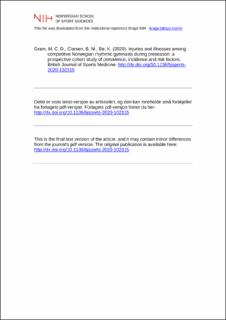| dc.contributor.author | Gram, Marte Charlotte Dobbertin | |
| dc.contributor.author | Clarsen, Benjamin Matthew | |
| dc.contributor.author | Bø, Kari | |
| dc.date.accessioned | 2020-10-21T06:28:51Z | |
| dc.date.available | 2020-10-21T06:28:51Z | |
| dc.date.created | 2020-09-04T14:10:42Z | |
| dc.date.issued | 2020 | |
| dc.identifier.citation | British Journal of Sports Medicine. 2020, https://doi.org/10.1136/bjsports-2020-102315 | en_US |
| dc.identifier.issn | 0306-3674 | |
| dc.identifier.uri | https://hdl.handle.net/11250/2684006 | |
| dc.description | I Brage finner du siste tekst-versjon av artikkelen, og den kan inneholde ubetydelige forskjeller fra forlagets pdf-versjon. Forlagets pdf-versjon finner du på bjsm.bmj.com / In Brage you'll find the final text version of the article, and it may contain insignificant differences from the journal's pdf version. The definitive version is available at bjsm.bmj.com | en_US |
| dc.description.abstract | Objectives: Rhythmic gymnastics is an Olympic sport that demands high training volume from early age. We investigated the extent of, and risk factors for, injuries among competitive Norwegian rhythmic gymnasts.
Methods: One hundred and seven of 133 (80.5%) female rhythmic gymnasts (mean age: 14.5 years (SD 1.6), mean body mass index: 18.9 (SD 2.2)) participated. All gymnasts completed a baseline questionnaire and the ‘Triad-Specific Self-Report Questionnaire’. Injuries, illnesses and training hours were recorded prospectively for 15 weeks during preseason using the ‘Oslo Sports Trauma Research Center Questionnaire on Health Problems’ (OSTRC-H2).
Results: Response rate to OSTRC-H2 was 97%. Mean overuse and acute injury prevalence were 37% (95% CI: 36% to 39%) and 5% (95% CI: 4% to 6%), respectively. Incidence was 4.2 overuse injuries (95% CI: 3.6 to 4.9) and 1.0 acute injuries (95% CI: 0.5 to 1.6) per gymnast per year. Overuse injuries in knees, lower back and hip/groin represented the greatest burdens. Previous injury increased the odds of injury (OR 30.38, (95% CI: 5.04 to 183.25)), while increased age (OR 0.61 per year, (95% CI: 0.39 to 0.97)) and presence of menarche (OR: 0.20, (95% CI: 0.06 to 0.71)) reduced the odds of all injuries and substantial injuries, respectively.
Conclusions: Overuse injuries were common among Norwegian rhythmic gymnasts. Younger gymnasts had higher all-injury risk. Gymnasts who were not menstruating had higher substantial injury risk. Injury prevention interventions should start at an early age and focus on preventing knee, lower back and hip/groin injuries. | en_US |
| dc.language.iso | eng | en_US |
| dc.subject | female athlete triad | en_US |
| dc.subject | gymnastics | en_US |
| dc.subject | injuries | en_US |
| dc.subject | overuse injury | en_US |
| dc.subject | risk factor | en_US |
| dc.title | Injuries and illnesses among competitive Norwegian rhythmic gymnasts during preseason: a prospective cohort study of prevalence, incidence and risk factors | en_US |
| dc.type | Peer reviewed | en_US |
| dc.type | Journal article | en_US |
| dc.description.version | acceptedVersion | en_US |
| dc.source.pagenumber | 7 | en_US |
| dc.source.journal | British Journal of Sports Medicine | en_US |
| dc.identifier.doi | 10.1136/bjsports-2020-102315 | |
| dc.identifier.cristin | 1827392 | |
| dc.description.localcode | Institutt for idrettsmedisinske fag / Department of Sports Medicine | en_US |
| cristin.ispublished | true | |
| cristin.fulltext | postprint | |
| cristin.qualitycode | 2 | |
